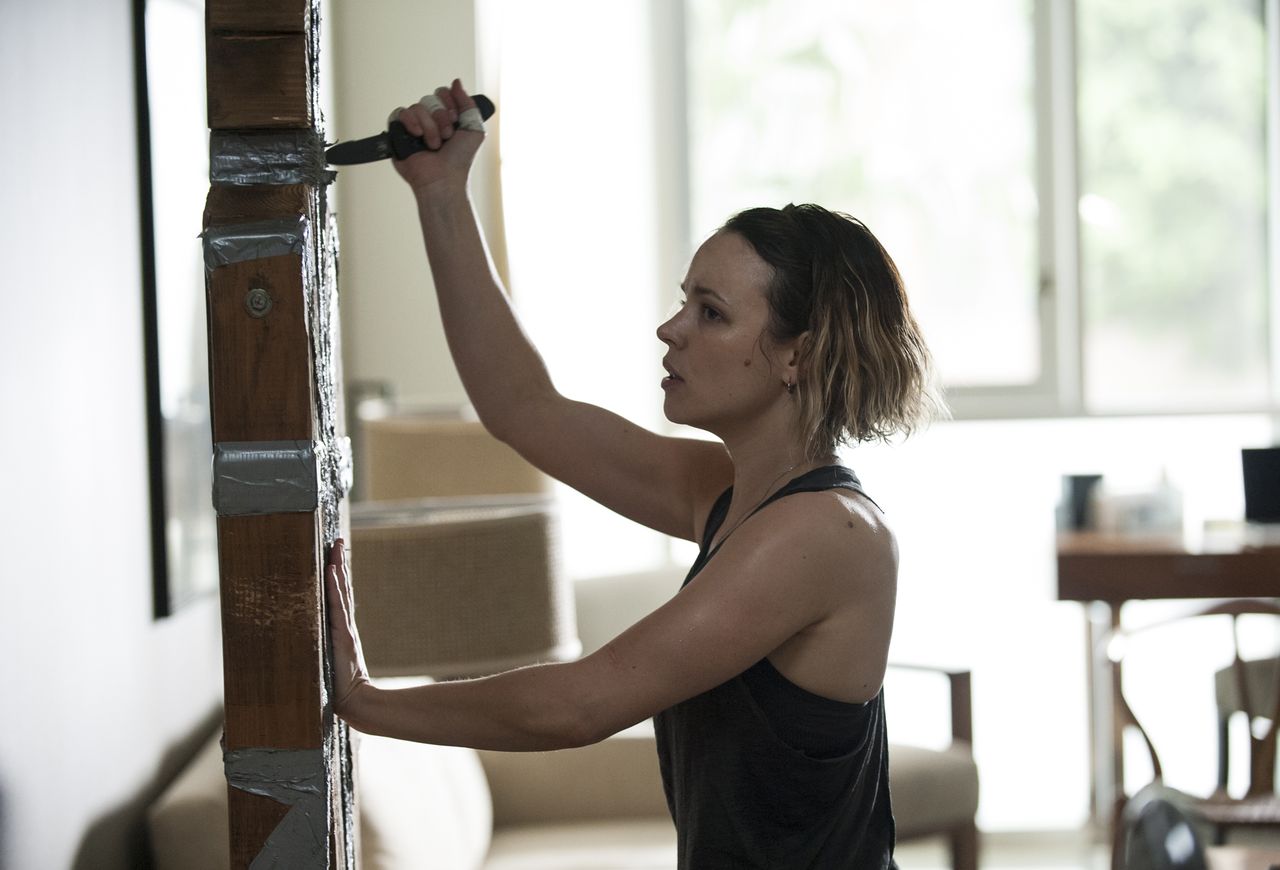True Detective episode 6 recap: No church in the wild
In the best episode of a dodgy season, our heroes team up to infiltrate California's sleaziest private party


This week's "Church in Ruins" is the first episode of True Detective's second season that managed to recapture some of season one's magic: propulsive storytelling, beautiful direction, and dialogue that managed to be enjoyably pulpy instead of obnoxiously pulpy. It's probably too late to save this misbegotten season, but for anyone who's still watching, it's a relief to see that True Detective still has something left in the tank.
After they sit down to coffee and work out their differences, Ray Velcoro tells Frank Semyon that his slimy subordinate Blake is running a complex prostitution ring, enlisting young, cash-strapped girls, sending them to Dr. Pitlor for extensive plastic surgery, and turning them into high-priced escorts for Los Angeles' most powerful men. (Incidentally, this is basically the plot of L.A. Confidential, which means this falls somewhere on the spectrum between "loving homage" and "outright theft.")
Blake's little side project happens to dovetail with Ani's latest mission: going undercover at an orgy to check out some leads on the Caspere murder. Given the enormous cost and effort required to groom women for his orgies, why does Blake happily accept Ani as a "freelancer" at his big party? True Detective doesn't give us a satisfying answer, but the mistake certainly costs him; by the end of the evening, a guard and a guest have been stabbed, and a long-lost missing person has been found and spirited away.
Subscribe to The Week
Escape your echo chamber. Get the facts behind the news, plus analysis from multiple perspectives.

Sign up for The Week's Free Newsletters
From our morning news briefing to a weekly Good News Newsletter, get the best of The Week delivered directly to your inbox.
From our morning news briefing to a weekly Good News Newsletter, get the best of The Week delivered directly to your inbox.
Detractors of True Detective's second season tend to argue that the lion's share of the credit for season one belongs to Cary Fukunaga, who directed every episode, and not Nic Pizzolatto, who created the series and wrote both seasons. While I generally think Pizzolatto's work on True Detective been unfairly undersold, "Church in Ruins" is a textbook example of how a talented director — in this case, Miguel Sapochnik — can overcome dodgy material.
Sapochnik's fingerprints were all over the episode's best scenes: the breakfast-table standoff between Ray and Frank, which crackles with the tension missing from their many barroom encounters; Ani practicing her stabbing routine on a dummy, which could easily have been goofy but instead feels appropriately menacing; or Frank using a nail gun to torture a man he was questioning, which was unsettling without ever becoming gratuitous.
"Church in Ruins" even manages to correct one of the season's earlier missteps: Stan, the henchman who was murdered as an apparent warning to Frank in True Detective's third episode. When Stan was killed, Frank cared — but we didn't, because True Detective never bothered to introduce him or give him anything interesting to do. Stan's death was baffling because we knew absolutely nothing about him, and it only grew more grating when characters kept referencing him like he had ever mattered to us.
That's the kind of mistake that's not shocking from a onetime novelist like Nic Pizzolatto; on paper, you could probably make a minor character like Stan feel like he matters: through exposition, or interior monologue, or even by his mere presence in a bunch of scenes. But the loss of the minor henchman never translated to the screen, and Frank and Jordan's trip to visit Stan's grieving wife and son in "Church in Ruins" could easily have felt like another pointless detour in an already overstuffed season.
Instead, it's Vince Vaughn's best scene this season: a hopeful monologue, delivered to a sad little boy, which actually allows Vaughn's natural charisma to shine. True Detective's second season has been obsessed with the idea of bad fathers. (Literally, all four of our protagonists have one; one of them is one, and one of them is probably on track to be one.)
That makes the episode's rare note of warmth, from a wannabe father like Frank Semyon, stand out. "Sometimes a thing happens, splits your life. There's a 'before' and 'after,'" says Frank to the kid. "But if you use it right — the bad thing — you use it right and it makes you better. Stronger. Gives you something most people don't have." It's the closest True Detective has come to a moral core all season, and it's strong enough to make you wish it had been placed earlier (even if Frank was probably responsible for the kid's dad's death).
"Church in Ruins" also makes the welcome decision to move the story forward by getting all three of our True Detectives together for Ani's tense, off-the-books infiltration of the orgy party. Ray and Paul work the perimeter, but this is Ani's show. Stripped of everything but a transmitter and an evening gown, she hunts for leads as the orgy begins to heat up. Unfortunately, a dose of a hallucinogen — purportedly molly, but probably something worse — brings her dark past into her dark present.
Miguel Sapochnik's finest directorial touch in "Church in Ruins" is Ani's phantasmagoric molly trip, which is largely shown from her perspective. At best, True Detective is high camp, and Sapochnik shoots it that way, with a Bernard Herrmann-esque string score and a restless, dizzy camera that can't quite focus on anything (including the weird sex happening at the corners of the frame). By the time Ani gets her wits back, shakes the old man that's been tailing her, and escapes, the heroes have gotten away with more than just their lives: They've rescued Vera Machiado, the drugged-up subject of the missing persons case Ani has been working, and snagged a contract full of names they can investigate. Score one for the good guys.
But there's still a bigger problem underscoring True Detective's second season: I still don't care who killed Ben Caspere, and I don't think the show does, either. Don't get me wrong. You can do the "single murder that leads to all kinds of unforeseen ripple effects for everybody else" thing. (Twin Peaks, a clear reference point for Nic Pizzolatto, did this extremely well.)
Right now, there are at least a half-dozen balls in the air: Ben Caspere, the corridor land grab, the Guerneville cult, the Chessani family, the person who shot Ray, the person who sent Ray to kill the wrong man. That's not even counting all the personal issues our four protagonists have yet to resolve: Ray's ex-wife and son, Frank and Jordan's desire to have a baby, Paul's attempts to suppress his homosexuality, and Ani's cocktail of personal, professional, and familial problems.
What is True Detective's second season about? With just two episodes left before this story is wrapped, I hope Nic Pizzolatto knows exactly how he's going to tie all these strands together.
Oh, and also:
- Before she gets killed, Irina Rulfo reveals that the bad guy who asked to pawn Ben Caspere's stuff was a "thin, white" cop. In a previous episode, we also learned that Ray was shot by riot shells — "the kind police use." It certainly looks like True Detective is setting us up for a twist; besides Ray, the only thin, white cop we've spent any real time with is Paul Woodrugh, whose moral compass has always been veiled. Could Paul be a dirty cop, working from the inside to send Ray and Ani astray? (If we're looking at thin, white cop suspects, I suppose Ani's ex-boyfriend is also a remote possibility.)
- Then again: The prevailing theory in True Detective's first season was that Marty Hart (Woody Harrelson) was the bad guy, and that certainly didn't go anywhere. Nic Pizzolatto clearly looks at red herrings as a feature rather than a bug. Given the second season's bizarre preponderance of background characters we're supposed to remember, I wouldn't be shocked if our thin, white, bad cop turns out to be a minor background player — or even somebody we haven't met before.
- In the midst of her hallucination, it's heavily implied that Ani was molested while growing up in her dad's creepy cult. In general, the cult is another aspect of the story that feels ripe for exploration — but with two episodes left, how much deeper can they go?
- Following his horrific showstopper in the season premiere, Colin Ferrell gets to deliver one more nasty threat: a promise to flay a man with a cheese grater if he ever gets out of prison. Gross.
- Fun fact: Miguel Sapochnik also directed the superlative Game of Thrones episode "Hardhome," which you might know better as "the one with all the white walkers."
- Best worst line of the week, as always, belongs to Frank Semyon: "On the ropes ain't the same thing as bleeding out." Seriously, does he have an "inspirational quote of the day" calendar lying around off-camera somewhere?
Sign up for Today's Best Articles in your inbox
A free daily email with the biggest news stories of the day – and the best features from TheWeek.com
Scott Meslow is the entertainment editor for TheWeek.com. He has written about film and television at publications including The Atlantic, POLITICO Magazine, and Vulture.
-
 The moon has been listed as a threatened historic site
The moon has been listed as a threatened historic siteUnder the radar Human influence has extended to space
By Devika Rao, The Week US Published
-
 Crossword: January 23, 2025
Crossword: January 23, 2025The Week's daily crossword
By The Week Staff Published
-
 Codeword: January 23, 2025
Codeword: January 23, 2025The Week's daily codeword puzzle
By The Week Staff Published